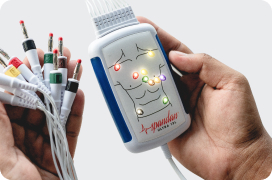
Author - Dr Radhika Sharma
Understanding T Wave Abnormality: Symptoms, Causes and Treatment
The T wave on an ECG depicts ventricular repolarization, or the return of normal resting membrane potential in the ventricular surface. Changes in the T wave morphology can be important insights into heart conditions and it can help with early diagnosis and management of several pathologies.
Normal T wave morphology
In a regular ECG, an upright low amplitude broad wave is seen after the QRS complex in leads I, II and V2-V6. It lasts for around 160 milliseconds.
Inverted T waves
An inverted T wave is considered abnormal when the inversion is deeper than 1.0 mm. However, some inverted T waves may be completely benign- they may be normally found in children, in persistent juvenile T wave inversion, and in normal variant T wave patterns.
However, in patients with chest discomfort, breathlessness, palpitations or fatigue, they may indicate ongoing ischemia or low blood supply of heart muscle, or acute coronary syndromes. Early recognition is aided by accompanying ST segment deviation, and can help diagnose ischemia before severe damage sets in. Cardiac markers and further tests may help initiate antiplatelet therapy and prevent complications. Of course, post-ischemia T wave inversions (seen after an episode of ischemia has lapsed) are relatively benign and do not require any immediate intervention. Patients who have implanted pacemakers may also show inverted T waves, which is nothing to worry about.
Other causes of inverted T waves, such as hypertrophic cardiomyopathy, bundle branch blocks and hypokalemia should also be kept in mind. Patients on digoxin, antiarrhythmics and diuretics like thiazides can have electrolyte abnormalities leading to dynamic changes in T wave appearance, and drug history should be considered when making a swift differential diagnosis.
Tall T waves
Narrow, symmetrical and tall T waves are characteristic of hyperkalemia. Hyperkalemia can be suspected in patients with acute or chronic renal failure, severe dehydration, burns, or due to drugs like ACE inhibitors or Angiotensin 2 Receptor Blockers (ARBs), which are potassium-sparing drugs. The symptoms can be very similar to those described above, but the management of hyperkalemia must be initiated once the serum potassium levels are above 5.5mEq/L. Management consists of intravenous calcium and insulin/glucose perfusion, salbutamol nebulization, and management of acid-base changes.
Tall T waves should not be confused with large T waves, which are hyperacute changes in the T wave morphology seen for seconds after an ischemic event. These are rarely seen.
Pseudnormalized T waves
One situation where the normal morphology of T waves is a sign of alarm is the pseudonormalized T wave. In patients with previous ischemia, the replacement of an inverted T wave with a normal T wave must lead to suspicion of an ischemic episode, regardless of the cause of the previous T wave inversion.
While a T wave abnormality immediately makes one reach for a diagnosis of ischemia, one must be careful before settling on the management. Keeping the symptoms and previous history in mind helps reach a rational and accurate diagnosis, especially in times of urgency.





